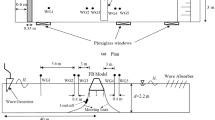Abstract
In this study, a perforated pontoon floating breakwater (FB) consisting of an impermeable plate and a perforated plate was designed to untangle the effect of a perforated plate on wave transmission and hydrodynamic performance of floating breakwater. A series of 2-D physical model experiments were conducted to measure the wave transmission coefficient, tension acting on the mooring line, and motion response of FB under a regular wave. The experimental results of the motion responses and mooring lines indicated that the new perforated plate was evidently effective. Furthermore, the study also discussed and analyzed the influence of the perforated plate on transmission coefficients. The experimental results showed that the new perforated plate did not lead to obvious improvement in the transmission performance
Similar content being viewed by others
References
Koutitas C. G., Karambas T. V., Koutandos E. V. Floating breakwater response to waves action using a Boussinesq model coupled with a 2DV elliptic solver [J]. Journal of Waterway Port Coastal and Ocean Engineering, 2004, 130(5): 243–255.
Gesraha M.R. Analysis of Π shaped floating breakwater in oblique waves: I. Impervious rigid wave boards [J]. Applied Ocean Research, 2006, 28(5): 327–338.
Elchahal G., Younes R., Lafon P. The effects of reflection coefficient of the harbour sidewall on the performance of floating breakwaters [J]. Ocean Engineering, 2008, 35(11-12): 1102–1112.
He F., Huang Z., Law W. K. Hydrodynamic performance of a rectangular floating breakwater with and without pneumatic chambers: An experimental study [J]. Ocean Engineering, 2012, 51: 16–27.
Peng W., Lee K. H., Shin S. H. et al. Numerical simu-lation of interactions between water waves and inclined-moored submerged floating breakwaters [J]. Coastal Engineering, 2013, 82(3): 76–87.
Koraima A. S., Rageh O. S. Effect of under connected plates on the hydrodynamic efficiency of the floating breakwater [J]. China Ocean Engineering, 2014, 28(3): 349–362.
Ouyang H. T., Chen K. H. Tsai C. M. Investigation on bragg reflection of surface water waves induced by a train of fixed floating pontoon breakwaters [J]. International Journal of Naval Architecture and Ocean Engineering, 2015, 7(6): 951–963.
Christensen E. D., Bingham H. B., Friis A. P. S. et al. An experimental and numerical study of floating breakwaters [J]. Coastal Engineering, 2018, 137: 43–58.
Weng W. K., Zhou C. R. Analysis of responses of floating dual pontoon structure [J]. China Ocean Engineering, 2007, 21(1): 91–104.
Tang H. J., Huang C. C., Chen W. M. Dynamics of dual pontoon floating structure for cage aquaculture in a two-dimensional numerical wave tank [J]. Journal of Fluids and Structures, 2011, 27(7): 918–936.
Chen Z. J., Dong H. Y., Zeng Z. et al. Time-domain hy-drodynamics analysis of pontoon-plate floating breakwater under waves actions [J]. Journal of Oceanography in Taiwan Strait, 2012, 31(1): 114–120.
Jarlan G. E. A perforated vertical wall breakwater [J]. Dock and Harbour Authority, 1961, 41(486): 394–398.
Williams A. N., Mansoup A. E. M., Hong S. L. Simplified analytical solutions for wave interaction with absorbing-type caisson breakwaters [J]. Ocean Engineering, 2000, 27(11): 1231–1248.
Zhu S., Chwang A. T. Analytical study of porous wave absorber [J]. Journal of Engineering Mechanics, 2001, 127(4): 326–332.
Li Y. C., Liu H. J., Teng B. et al. Reflection of oblique incident waves by breakwaters with partially perforated wall [J]. China Ocean Engineering, 2002,16(3): 329–342.
Teng B., Zhang X. T., Ning D. Z. Interaction of oblique waves with infinite number of perforated caissons [J]. Ocean Engineering, 2004, 31(5-6): 615–632.
Liu Y., Li Y. C., Teng B. The reflection of oblique waves by an infinite number of partially perforated caissons [J]. Ocean Engineering, 2007, 34(14): 1965–1976.
Huang Z., Li Y., Liu Y. Hydraulic performance and wave loadings of perforated/slotted coastal structures: A review [J]. Ocean Engineering, 2011, 38(10): 1031–1053.
Lee J. I., Shin S. Experimental study on the wave reflec-tion of partially perforated wall caissons with single and double chambers [J]. Ocean Engineering, 2014, 91: 1–10.
Stiassnie M., Drimer N. On a freely floating porous box in shallow water waves [J]. Applied Ocean Research, 2003, 25(5): 263–268.
Wang H. Y., Sun Z. C. Experimental study of a porous floating breakwater [J]. Ocean Engineering, 2010, 37(5-6): 520–527.
Shih R. S. Experimental study on the performance charac-teristics of porous perpendicular pipe breakwaters [J]. Ocean Engineering, 2010, 50(5): 53–62.
Lee J., Cho W. Effects of mean wave drift force on mooring tension and performance of a moored floating breakwater [J]. Journal of Civil Engineering, 2002, 6(2): 193–201.
Loukogeorgaki E., Angelides D. C. stiffness of mooring lines and performance of floating breakwater in three dimensions [J]. Applied Ocean Research, 2005, 27(4): 187–208.
Author information
Authors and Affiliations
Corresponding author
Additional information
Project supported by the National Natural Science Foun- dation of China (Grant Nos. 51309124, 51679113 and 51379095).
Rights and permissions
About this article
Cite this article
Ji, Cy., Chen, X., Ma, Xj. et al. The influence of perforated plates on wave transmission and hydrodynamic performance of pontoon floating breakwater. J Hydrodyn 30, 522–530 (2018). https://doi.org/10.1007/s42241-018-0057-y
Received:
Accepted:
Published:
Issue Date:
DOI: https://doi.org/10.1007/s42241-018-0057-y



